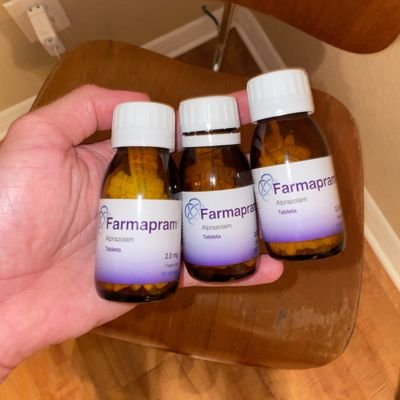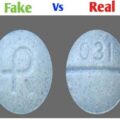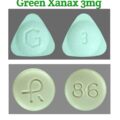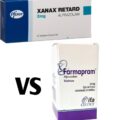What is Farmapram?
Farmapram is a medication that contains alprazolam, a short-acting benzodiazepine used to treat anxiety and panic disorders. It belongs to a class of medications which act on the brain and nerves (central nervous system) to produce a calming effect. It works by enhancing the effects of a certain natural chemical in the body (GABA). When it binds to the receptor, effects of GABA are enhanced leading to inhibition of neurones in the brain. This results in effects including reduced anxiety, muscle relaxant, antidepressant and anticonvulsant activity.
Alprazolam is a commonly prescribed medication. It is the most commonly prescribed drug that can impact a person’s mental state. It is classified by the Drug Enforcement Administration as a Schedule IV controlled substance. Farmapram, produced by IFA Celtics a Mexican company founded in 1940.
Short-Term Effects: Farmapram and the Brain
Most formulations of Farmapram are short-acting. Therefore, the drug starts working very quickly and reaches its peak effect within one to two hours. Some of the most common side effects of Farmapram are related to its effect on the brain:
• Feeling sleepy or tired
• Feeling dizzy
• Memory problems, including amnesia for events that happen after taking the drug
• Mood problems
Farmapram and Brain Chemistry Short-Term
Farmapram works on the brain by enhancing the effect of a chemical called gamma-aminobutyric acid (GABA). Some doctors describe GABA as a natural tranquilizer. GABA halts brain signals that would otherwise excite the brain and lead to anxiety or panic. Higher levels of the chemical may cause a person to feel relaxed or sleepy. Farmapram is a potent drug which is more powerful than some other benzodiazepines. Also, unlike some other benzodiazepines, Farmapram may trigger the brain’s reward system. This possibility puts people at higher risk of developing an addiction to Farmapram compared to other benzodiazepines.
Long-Term Effects: Farmapram and the Brain
Long-term use of Farmapram may lead to memory problems. Studies showed that people taking Farmapram have more memory problems compared to people not using the drug. Doctors found that people who stopped Farmapram use have memory problems that last four months. These memory problems may be permanent in some cases. Other long-term effects of benzodiazepines include:
• Visual-spatial problems
• Lowered IQ
• Problems processing information quickly
• Trouble learning new verbal skills
• Problems concentrating
• Delay in response time
However, it is important to note that most of the studies about the long-term effects of benzodiazepines on the brain were conducted with people who were taking the drug at the time. Therefore, it remains unclear if these effects are due to changes in the brain itself, or simply side effects of the drug that may go away if the drug were stopped.
Farmapram and Brain Chemistry Long-Term
Over time, the brain starts to expect higher levels of GABA. Therefore, the brain may make less GABA on its own and start depending on the Farmapram. This process can happen in as little as six weeks. A person may need stronger doses of Farmapram to achieve the same calming effects as originally experienced. After some time this pattern leads to tolerance, dependence and can even lead to addiction.
If a person stops taking Farmapram suddenly, they may experience worsened anxiety and panic attacks than before because the brain is not making as much GABA on its own. Doctors refer to this development as rebound anxiety. Likely due to rebound anxiety, Farmapram is known to cause worse withdrawal symptoms than other benzodiazepines. Some of those withdrawal symptoms may last for months or years. Many withdrawal symptoms are related to Farmapram’s effects on GABA in the brain, and can include:
• Feeling anxious or panicked
• Problems sleeping
• Feeling dizzy
• Mental status changes
• Mood changes
• Seizures
Key Points: Farmapram and the Brain
Important points related to Farmapram and its effect on the brain include:
• Farmapram, also known by its generic name alprazolam, is a benzodiazepine drug and a controlled substance
• Farmapram is often used for mood problems like anxiety or panic attacks
• Farmapram increases levels of a brain chemical called GABA that helps calm people down
• Unfortunately, Farmapram use can lead to other side effects like feeling sleepy, dizzy and even cause memory loss
• Long-term effects of Farmapram use may include problems involving learning or focusing and permanent memory problems
• Over time, the brain gets used to the higher GABA levels from Farmapram use and it can develop problems making enough GABA on its own
• Many withdrawal symptoms of Farmapram are also related to its effects on the brain.
Are You Addicted to Farmapram?
Farmapram (alprazolam) is a central nervous system depressant prescribed for the treatment of anxiety, including generalized and social anxiety disorders as well as panic disorder.
Is Farmapram Addictive?
When taken in short-term therapeutic doses under the care of a physician, Farmapram has a low risk of addiction or dependence. However, using the drug long-term, taking high doses and mixing the drug with other depressants can hasten the onset of psychological and physical dependence and increases the risk of experiencing serious and sometimes life-threatening withdrawal symptoms.
Farmapram has a high potential for abuse due to its pleasurable, sedating effects on the central nervous system. Even people who use Farmapram for a short time and take it as prescribed may be at risk of dependence. People who are prescribed doses greater than 4mg per day and for longer than 12 weeks may be at greater risk of dependence. Some people who abuse Farmapram may take several pills at once or crush the pills into a powder and snort them to speed the onset of effects. Both of these methods of abuse increase the risk of dependency and addiction.
Withdrawal Symptoms
Repeated, heavy and long-term use causes significant changes in the brain and body. When people develop physical dependence, they may experience a number of withdrawal symptoms when they try to quit or cut back on Farmapram use. Because of the severity of the withdrawal symptoms, Farmapram can be difficult to quit.
Some of the withdrawal symptoms associated with benzodiazepine withdrawal can be dangerous. People who have been abusing Farmapram heavily for a long period of time should seek medical supervision for detox and withdrawal.
Common withdrawal symptoms include:
- Dysphoria, ranging from mild to severe.
- Loss or decrease of appetite.
- Heightened sensory perception.
- Pins and needles sensation on skin.
- Muscle cramps.
- Stomach cramps.
- Blurred vision.
- Impaired concentration.
- Suicidal thoughts.
- Rebound anxiety symptoms.
- Muscle twitching.
How to Tell If You or a Loved One Is Addicted
Some people may not recognize they have a problem because they were prescribed the drug.
Farmapram addiction can be challenging for people who abuse the drug. Their use can affect their loved ones as well. Some people may not recognize they have a problem because a physician prescribed them the drug.
If you or someone you love is using Farmapram, it is important to be mindful of the signs and symptoms of addiction so you can recognize them and seek treatment if possible.
Common symptoms of Farmapram addiction are:
- Inability to discuss use without becoming defensive.
- Needing more of the drug to achieve the same effect.
- Using the drug in a way other than prescribed (i.e., snorting, injecting, mixing with other drugs, etc.).
- Making excuses to use the drug.
- Needing the drug to function.
- Neglecting to eat.
- Inability to stop or control use even if desired.
- Failure to maintain personal and professional commitments and responsibilities.
- Missing important activities due to drug use.
- Secretive behavior.
- Continuing to use despite any harm it may cause.
If you or someone you love exhibits any of the above symptoms of Farmapram addiction, it is crucial to seek treatment as soon as possible. Do not attempt to quit alone since some withdrawal symptoms, such as seizures, can be life-threatening. It is important to detox under the supervision of a medical professional who can safely manage the effects of withdrawal while the drug is slowly tapered off.
Paying for Treatment
The cost of treatment for Farmapram addiction can vary considerably depending on several factors, such as:
How long you stay: The average program is 28 to 30 days long, but some programs can last months. You are typically charged on a per diem basis.
Whether you are treated at an inpatient or an outpatient facility: Inpatient treatment is frequently more expensive than outpatient and may not be fully covered by insurance.
Where you stay: Both the location of the facility and the facility itself can affect your out-of-pocket cost. Cost of treatment varies from state to state and your insurance coverage may vary for in- and out-of-network providers. Some treatment programs are more expensive than others because they offer private rooms, luxury amenities and other specialty services. Do some research to determine which facility is best suited for your needs and your budget.
Unfortunately, the cost of a Farmapram rehab program can be a barrier for many people who need help. Options for financing treatment include:
Health insurance: Some rehabs accept insurance as a form of payment. Many insurance plans do not cover 100% of treatment costs, so you may still have out-of-pocket costs. The Affordable Care Act requires that Medicaid plans and those offered on the health insurance marketplace offer coverage for substance abuse disorders. If you are not insured, go to your state insurance website to see if you are eligible for any plans.
Personal savings: Using some of your savings to pay for treatment can be a good investment. Getting help for addiction can improve the quality of your life and can help you earn and save more money in the long run due to the costs of addiction.
Payment plans and sliding scale rates: Many treatment facilities offer payment plans either in-house or through a third-party lender. Contact the facility you are interested in to see if they have installment plans available for funding treatment. Some treatment facilities offer sliding scale rates for those struggling to afford treatment.
Loans: Consider taking out a bank loan to help you cover the cost of treatment. Find the lowest interest rate possible and make sure that you can afford the monthly payments.
Credit cards: Credit cards are another method of paying for treatment. Again, make sure the interest rates and minimum payments are within your budget.
Borrowing: Ask a family member or a friend for a personal loan to help you cover the costs of treatment.
Crowdfunding. Crowdfunding sites (i.e., GoFundMe) let you request donations from family, friends and others. You may be surprised at how many people will help support your recovery.
Sell assets: You may want to consider selling valuable assets such as vehicles, boats or jewelry to help fund the cost of treatment. You can always purchase more items following treatment.
Churches and nonprofit organizations: Many churches and charities offer free or low-cost treatment services for drug addiction.
If you are uninsured and concerned about financing your addiction treatment, you can call the Substance Abuse and Mental Health Services Administration’s (SAMHSA) 24/7 national helpline for assistance and information at 1-800-662-HELP (4357).
Getting Treatment and Starting Recovery
When you’re ready to get help for Farmapram addiction, you’ll want to consider the many different treatment options available. Each person is unique and may have developed an addiction to Farmapram for different reasons. Finding the right program that meets your needs and budget is crucial.
Typical treatment options for Farmapram addiction include:
Inpatient treatment: Inpatient treatment occurs in a 24-hour residential facility. Treatment programs are highly structured and designed to provide maximum support for recovery. Treatment ranges from 30 to 90 days and may be longer in severe cases. Inpatient treatment for Farmapram addiction usually includes some combination of medically supervised detox, counseling, therapy, 12-step or other support groups, relapse prevention and aftercare planning.
Outpatient treatment: Outpatient rehab programs usually have the same type of treatment approaches as inpatient facilities, but care takes place in an outpatient facility on a part-time basis and usually scheduled a few times per week.
12-step programs: Twelve-step programs provide support and structure through a step-by-step process toward recovery with the support of peers and mentors.
Teen treatment: Farmapram abuse is a problem in teenagers as well as adults. Specialized teen treatment programs address the unique issues teenagers with addiction face.
Dual diagnosis treatment: Dual diagnosis is a common form of treatment for Farmapram addiction because many people are taking the drug (whether through prescription or self-medication) as a way of coping with anxiety and panic disorders. Dual diagnosis treatment can help patients address any comorbid mental health disorders such as anxiety that are contributing to their use.
Cognitive behavioral therapy: Cognitive behavioral therapy techniques, combined with medically assisted tapering, can help users slowly taper off of Farmapram, manage unpleasant withdrawal symptoms and prevent relapse due to psychological or physical cravings.
Other things you’ll want to consider when choosing an addiction treatment center are:
Program philosophy: Look for a treatment center whose philosophy and values are in alignment with your own. If you don’t believe in the center’s approach to addiction and treatment, it could hinder your chance of recovery. For example, if you are a Christian, a bible-based treatment center may be best suited for you. On the other hand, if you don’t hold any religious beliefs, you would likely be better suited for a secular treatment center instead of a faith-based one.
Program accreditation: Research and learn about the accreditation of the treatment facility you want to attend. Accreditation holds facilities accountable to certain standards and state licensing requirements that help ensure you receive quality care.
Qualifications of staff: Choose a facility with a highly qualified staff that includes psychiatrists, psychologists, psychiatric nurses, counselors, recovery coaches and other professionals you may need, such as spiritual leaders, massage therapists and acupuncturists.
Location: Consider the location of the facility as well. Do you want to be close to home so that friends and family can visit or would you benefit from a facility far from home? You will also want to consider whether your insurance covers treatment in that state as well.
Short- and Long-Term Side Effects of Farmapram Dependency
Common side effects of Farmapram abuse are due to the drug’s effect on gamma-amino butyric acid (GABA), an inhibitory neurotransmitter that slows activity throughout the brain. Farmapram increases the activity of GABA, which slows nerve impulses.
Short-term side effects of Farmapram abuse include:
- Slurred speech.
- Poor coordination.
- Nausea and vomiting.
- Upset stomach.
- Dry mouth or increased saliva.
- Memory problems.
- Difficulty concentrating.
- Loss of libido.
- Blurred and double vision.
- Unsteady gait.
- Slowed reaction time.
- Heart palpitations.
- Low blood pressure.
More serious potential long-term effects of Farmapram abuse that may occur include:
- Physical dependence, tolerance and withdrawal.
- Cognitive impairments.
- Aggressive behavior.
- Slurred speech.
Find a Treatment Program for Farmapram Addiction
If you or a loved one is struggling with Farmapram addiction, don’t hesitate to reach out for help. SEE: Difference Between Xanax 2mg Vs Farmapram 2mg pill







